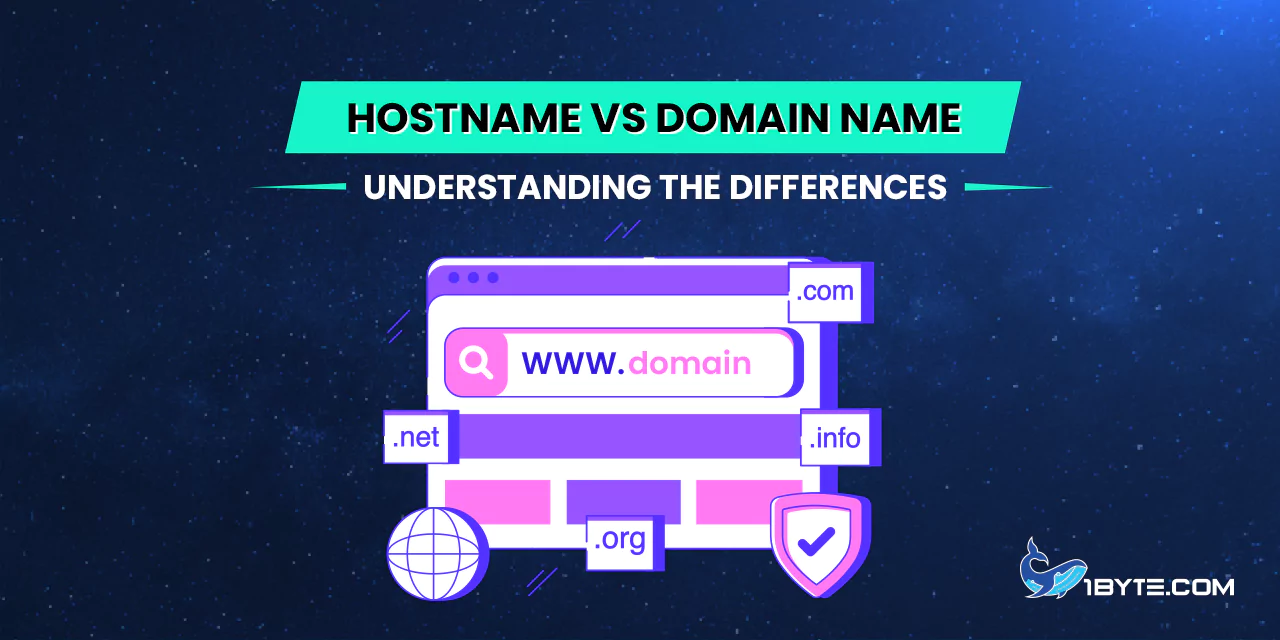The world of web addresses is confusing enough, let alone trying to know exactly where the differences lie between hostname vs domain name. The fact is, many users still confuse these two essential components of internet conversations.
In this article from 1Byte, we’ll walk you through the main differences between hostnames and domain names by example and linking to reports that back that up. If you are tech enthusiast or a business owner, understanding the differences between these is very necessary while managing your network and keeping your online presence strong.
What is a Domain Name?
The domain name is a human readable means of accessing the web over the internet. An IP address is a string of numbers. It’s easier to remember than that. example.com” is a domain name for instance, while its IP address could be ‘192.0.2.1’ for example.
An estimated 367 million domain name registrations were carried last year alone. The most common still being .com but alternative TDLs like .xyz are growing quickly.
It is important for businesses and individuals alike to have domain names. They create online presence, can influence SEO. For instance, a well selected domain name can help the visibility of your website on search engines.
FURTHER READING: |
| 1. How to Secure a Domain Name: 7 Essential Steps |
| 2. .us vs .com: Which Domain Extension is Right for You? |
| 3. .org vs .com: Which Domain Extension is Right for You? |
How domain names are structured (top-level domain, second-level domain, etc.)

Just like the internet’s phonebook, domain names help making finding a website easy without having to remember an IP address. They are of several parts and each completes a purpose.
Top-Level Domain (TLD)
A .com, .org or .net is the last part of a domain name. The domain’s purpose or geographic location is indicated by it. For example, .com has the commercial sites, whereas .gov has government sites.
Second-Level Domain (SLD)
The TLD will come after the SLD, which refers to the organization or individual. For instance, in example.com, example is the SLD.
Subdomain
They will be followed by an SLD and the subdomains they contain are optional. They can be used to group (divide or section) website items. For example, blog.example.com uses actual blog as a subdomain.
Root Domain
The SLD plus TLD form the root domain. The root domain in example.com would be example.com.
Examples
- www.example.com: www is a subdomain, example is the SLD, and .com is the TLD.
- shop.example.com: shop is a subdomain, example is the SLD, and .com is the TLD.
What is a Hostname?
The label that is assigned to a device on a network is called the hostname, which is a human readable label. It’s a more user friendly way of replacing IP addresses that just are a string of numbers. The hostnames make it easier to identify and communicate with the devices in a network.
For instance, a hostname could be Johns-Main-Computer or Sara-Laptop-New. Hostnames are device specific, which is to say you can assign them almost anything you want, not like IP addresses which can be set anywhere on the internet.
Fully qualified domain names (FQDN), the combination of hostnames and domain names to a pinpoint specific network location, require hostnames. For example, in the host name “mail.acme.org” the host name is “mail”.
According to the latest Namecheap Domain Insights & Trends Report 2023, the use of hostnames continues to grow as businesses and individuals seek more personalized and recognizable network identifiers.
How hostnames are used within networks

Network operations heavily rely on hostnames. They make it easy to discover and communicate with devices on a network. Hostnames don’t use numerical IP addresses, which are challenging to remember, instead, they affix a developer-friendly name to each device.
Say, for instance, a machine with the IP address 192.168.1.10 can be configured to have a hostname such as Office-PC. It makes this easier for users to find and connect to devices on the network.
DNS resolution also uses hostnames. DNS (Domain Name System) tells a ‘human friendly’ host name to a ‘computer friendly’ IP address so that you can open a web page or even do any other network activities with ease. The access to use on the internet requires this process.
Also, server connections are based on hostnames. Users can connect to a remote server using its hostname instead of taking its IP address. It makes the process easier, and lessens the risk of error.
In essence, hostnames are helpful in overall network management and users’ experience by essentially describing devices in a network in an easy way to be recognized and interact with.
Key Differences Between Hostname vs Domain Name
Understanding the differences between a hostname and a domain name is crucial for efficient network management and establishing a strong online presence.
Detailed comparison (purpose, structure, use cases)
In order for you to better understand the differences between hostname vs domain name, we’ve conducted a detailed comparison of the two concepts.
Purpose
- Hostname: Identifies a device on a network. It’s a human-readable label that makes it easier to identify and communicate with devices.
- Domain Name: Identifies a website or a resource on the internet. It’s used to navigate to a specific site and is more recognizable to humans than an IP address.
Structure
- Hostname: Typically consists of a single word or a combination of words separated by dots. For example, mail.example.com.
- Domain Name: Includes a top-level domain (TLD) and a second-level domain (SLD). For example, example.com.
Use Cases
- Hostname: Used within local networks to identify devices. For instance, a company’s internal email server might have the hostname mail.company.local.
- Domain Name: Used to access websites on the internet. For example, www.example.com is a domain name that people use to visit a website.
Examples
- Hostname Example: server1.localnetwork.com.
- Domain Name Example: www.techblog.com.
Why it’s important to distinguish between the two

It’s important to know the difference between the domain name and hostname, for a few reasons. The first is the help it gives in network management. It can simplify troubleshooting and configuration tasks to know if you are dealing with a hostname or a domain name. Something as simple as a hostname is used to identify exactly which device is on a network, while a domain name is used to identify a website.
Second, it enhances security. This allows administrators to know what security measures are needed for each. For instance, securing a domain name could set itself up against cyber attacks and securing a hostname could mean that only any authorized devices can use the hostname.
It also improves communication. Being clear in terms of its communication channels within a network can assist in setting it up and maintaining them. For instance, one handle, hostnames, is applied to internal servers while another one, domain names, is assigned to public websites.
Being able to distinguish the two also aids in resource management lastly. It helps in proper distinction between domain names and hostnames and thereby helps in efficient network resource use. Imagine a naming convention that’s well organized, avoiding conflicts, and making a large number of devices and websites easier to handle.
By understanding such differences, businesses get an optimum opportunity to work on their network operations, improve security and therefore total efficiency.
Leverage 1Byte’s strong cloud computing expertise to boost your business in a big way
1Byte provides complete domain registration services that include dedicated support staff, educated customer care, reasonable costs, as well as a domain price search tool.
Elevate your online security with 1Byte's SSL Service. Unparalleled protection, seamless integration, and peace of mind for your digital journey.
No matter the cloud server package you pick, you can rely on 1Byte for dependability, privacy, security, and a stress-free experience that is essential for successful businesses.
Choosing us as your shared hosting provider allows you to get excellent value for your money while enjoying the same level of quality and functionality as more expensive options.
Through highly flexible programs, 1Byte's cutting-edge cloud hosting gives great solutions to small and medium-sized businesses faster, more securely, and at reduced costs.
Stay ahead of the competition with 1Byte's innovative WordPress hosting services. Our feature-rich plans and unmatched reliability ensure your website stands out and delivers an unforgettable user experience.
As an official AWS Partner, one of our primary responsibilities is to assist businesses in modernizing their operations and make the most of their journeys to the cloud with AWS.
Conclusion
Knowledge of the differences between domain name and hostname is necessary for effective network administration and setting a strong Internet presence. The difference between hostnames and domain names is that hostnames identify devices on a local network whereas domain names refer to websites that exist on the internet. Understand these distinctions, and you can make decisions about how best to run your online infrastructure.
In summary, knowing the differences between hostname and domain name empowers you to optimize your network and enhance your online presence. Stay informed and make the best choices for your digital needs.

